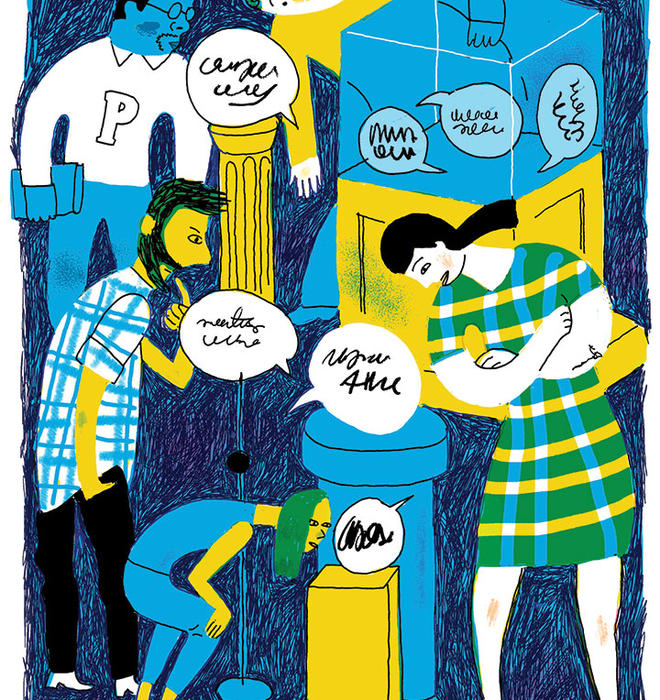
PEOPLE THOUGHT HE WAS JUST A FACEMAN, the kind who’d get swassed left and right, but then he started avoiding the Street, hitting the libe, showing up at the ’cepts, no more gut-hopping, and pretty soon he got known as a real wonk, the kind who buckles down on his thease well before closing time.
If you didn’t go to Princeton in the 1960s, at least some of this description might puzzle you. Most of the terms were taken from the 1965 Freshman Herald. A liberal translation: “Everyone saw him as a superficial guy who’d get rejected at the eating clubs, but he deserted Prospect Avenue, went to the library, attended all his precept sessions, stopped taking easy classes, and soon acquired a reputation as a real studier who’d work on his thesis far ahead of the deadline.”
Some of the terms, like wonk or gut, are still around, known to college students around the country. Yet where else but at Princeton would the Street be instantly recognizable as Prospect Avenue, home to the eating clubs? What Princeton student doesn’t know about the dreaded senior thesis, unaffectionately known as the thease (and far worse)? People, places, and practices distinguish a group from those outside, producing a verbal shorthand for all manner of experiences. At their highest, they form a code or shibboleth, as sure as eating mystery meat at Commons makes you york.Language at Princeton has lately endured scrutiny for its entrenched terms, including the “master” of a residential college — a title recently changed. But terms particular to an institution evolve as the place itself changes. What James Axtell in The Making of Princeton University calls Princeton patois includes such familiar terms as the Dinky, which was once known as the PJ&B, or Princeton Junction and Back. The term campus to mean a school’s grounds is probably a Princeton coinage, the first known use dating to a student’s 1774 letter describing the purloining and incineration of the steward’s tea: “Having made a fire in the Campus, we there burnt near a dozen pounds, tolled the bell and made many spirited resolves.” Previously, yard was the term, as in “Harvard yard,” but this clearly was not a Boston tea party.
Back in 1953, a Princeton senior named Dave Burns published a piece called “The Cliché Expert” in The Tiger. A riff on Frank Sullivan’s “The Cliché Expert” series in The New Yorker, Burns’ version sticks to Princeton lingo, claiming, “I’m no simple tool,” but the prospect of final exams is getting to him: “I’ve clutched. I’m all tensed up” (the opposite of nowadays, when to clutch is a saving maneuver). Earlier attempts to showcase Princeton patter include a roundup in PAW from 1929, which mentions softie, “one who lets his studies interfere with his education,” and the all-purpose ejaculation Geest!
READ MORE: Toughies, Smoothies, and High-Class Wolfing — PAW's 1929 primer on the campus vernacular
Princeton forms its own world, and to some extent it’s a world built of words. Perhaps for this reason, Joshua T. Katz, the Cotsen Professor of Humanities and a linguist in the classics department (and a PAW board member), decided to offer LIN 220: Language at Princeton for the spring 2016 semester. As one student, Julia Fitzgerald ’18, said: “Princeton seems to really work to create a language that strengthens its identity, its sense of its own difference and specialness.” Her class project focused on Princeton’s linguistic dichotomy, her term for the students’ tendency to use disparaging vocabulary to describe their college experience to other Princeton students while romanticizing it to people off-campus. Another student, Anna Leader ’18, wrote, “It gave me a chance to explore a place I’ve been living for four years.” In fact, as Katz notes, “Students at Princeton have a remarkably limited sense of Princeton’s history,” and one way of deepening their outlook is through language.
Though what’s specific to Princeton may be sometimes hard to claim (whose property is townie?), American linguists have long been interested in school slang. Volume 2 of Dialect Notes back in 1896 includes a section with the heading “College Words and Phrases,” derived largely from a survey sent to colleges across the nation. Of course, a lot of slang expressions aren’t new vocabulary so much as old words with new meanings, often humorous, so that diploma becomes sheepskin. It’s edifying that college in this volume is slang for an outhouse.
So what belongs to Old Nassau and not Harvard Yard? Start with anything using Nassau, from the song “Old Nassau” to “the Nass,” the diminutive for Nassau Weekly. Include all references to tiger (in the college cheer by around 1879) or orange and black (dating back to the late 1860s) or just sidelong tigrine references (like PAW, begun in 1900). Don’t omit the curious rituals, from the annual Cane Spree to the Nude Olympics, honored in both the breach and the observance until banned in 1999. For performances with more conscious artistry, see arch sings, where a cappella groups like the Tigertones crooned in places like Blair Arch. Put on the list Woody Woo, which provided a career path for many students, even if Woodrow Wilson 1879’s legacy has come under fire, and the Wa, which filled so many student stomachs. And don’t forget offerings such as ’cepts for (precepts) and ’zee groups (for advisees).
Of course, Prospect Avenue (“the Street”) and its eating clubs have provided grist for a lot of argot, from getting hosed or cut at Bicker to humming right in, perhaps by a body bid. The vernacular also includes euphemisms such as library fines from Chancellor Green Library, to mask drink tabs on a student bill after the library became a pub in 1973. On the other side of the table, so to speak, is what might be called Commons talk: mystery meat, green death, snakemeat, and elephant scabs (breaded veal cutlets). Allusions to drink are almost always alcoholic: pre-game (drinking), crump (to collapse after drinking), hooker (a drink, 1930s), touching it (1930s); also chug, york; see also beast for beer, boot for vomit, and McCoshed (to be sent to the infirmary because of inebriation).
As for sex, the average Princeton student from bygone decades at least talked a good game. Terms like flush or flushogram (a note backing out of the arrangement), snow (to come on strong), queen (a real babe), Cliffedweller (think Radcliffe), import (women brought in from off campus), rack (score), snake (to grab someone’s date), and wife (a roommate who gets sexiled during a crucial night) showed the hopeful horizons of a male Princeton student.
In academics, the University offers not just killer courses and the grinds or wonks who ace them, but also guts that you can punt, such as Rocks for Jocks, Volts for Dolts, Nuts ’n’ Sluts (Social Deviance), Physics for Poets, and Stars for Stoners, a nickname for AST 205: Planets of the Universe. Note: This last course is in fact a rather difficult class involving real math. Slang is often poetic but not necessarily accurate. Consider also the places where classes and other events are held, from the EQuad to the Greek twins Whig-Clio, the Stone for the Harvey S. Firestone Library, MoDo for Murray-Dodge Hall, and more recently RoMa, the nickname for the Rockefeller/Mathey College dining hall.
Princeton alums have also done their part, showing up annually and spawning the term reuner. And who could forget the locomotive, the Princeton cheer with its “sis, sis, sis,” the sound of a steam engine?
One recent instance of slang catching on, traced by research in Katz’s class to a single source, is the term f-shack for Firestone Library. It stems from a mass email sent to the senior class by one student, who lifted the term from a friend, who heard it from a 2010 film called The Other Guys. The term combines insouciance and convenience with a dash of humor that eases the hours of studying. “Meet you at the f-shack,” students now text each other.
So what’s changed over the years? The all-important PUID is now the prox card, though, as Chance Fletcher ’18, a history major and member of Katz’s class, points out, “The U-Store clerk I spoke to didn’t know the term.” One fertile area for new terms, as Katz notes, lies in the abundance of outdoor art on campus and the labels attached to them. Henry Moore’s Oval with Points was once known as “Nixon’s nose.” Stay tuned for the completion of the arts-and-transit project later this year.







1 Response
Ross D. Hall *70
8 Years AgoLinguistics and Language
I read with great interest the Jan. 11 “Let’s Talk Language” issue and was pleased to learn of the expansion of the undergraduate program in linguistics, having been a member of a similar effort on the graduate level a half-century prior. The launching of the first satellite in 1957 by the Soviet Union caused a strong reaction in this country that produced the National Defense Education Act, designed to upgrade post-secondary curricula in fields considered critical to the country’s strength, if not survival. One such field encompassed language analysis and instruction, of which linguistics was a part.
Princeton was one of several universities selected to develop three-year Ph.D. programs and enrolled five graduate students in the fall of 1962 under the direction of Professor William G. Moulton ’35, one of the nation’s foremost Germanic language scholars.
My other reason for writing is to add to “Princeton Patter.” As graduate students, our group manifested the “library habit,” which meant spending as many hours a day in Firestone as possible. It was a matter of prestige to be seen entering the library, likewise an embarrassment to be seen leaving it.